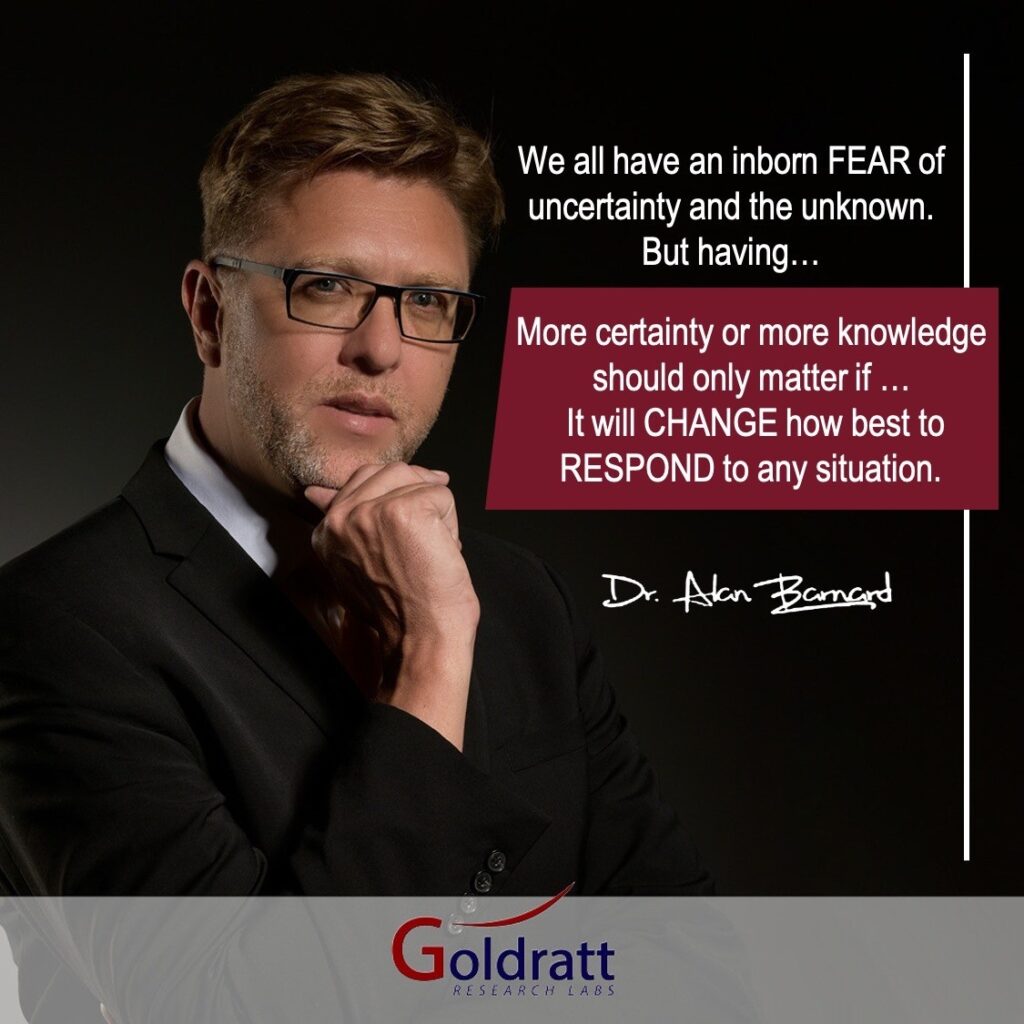Uncertainty and the Unknown
Humans evolved to have a FEAR of uncertainty and the unknown for a very good reason. In general, it PROTECTS us from doing things or being in situations that could harm or even kill us, and those we care for.
Some psychologist calls it the “fear that rules them all”, as many other fears and phobias are simply manifestations of this fear. Fear of the dark and fear of strangers are examples of this.
But sometimes this fear, when coupled with intolerance of uncertainty and the unknown, has the unintended consequences of doing the opposite, of causing us, and those we care about, unnecessary and avoidable harm.
Sometimes this fear has the unintended consequence of causing us, and those we care about, unnecessary and avoidable harm.
Being intolerant of uncertainty and the unknown is a lot like having an allergy. It is not the bee sting that will cause you any significant harm. It is the over-reaction, your body’s exaggerated stress response, that will cause you serious harm. Sometimes the body’s over-reaction can even be fatal.
Anxiety
Intolerance and sensitivity to uncertainty or the unknown can also have serious unintended consequences. Research has shown that several anxiety disorders, including panic disorder, social anxiety disorder, and specific phobias, share a common underlying trait: increased sensitivity to a perceived uncertainty threat, or fear of the unknown.
Anxiety disorders are increasingly common and don’t discriminate. About 30% of the population will suffer from some type of anxiety disorder during their lifetime. Although the majority of people (44%) that are impacted by anxiety disorders will experience only mild symptoms, 33% will have moderate symptoms, and 22% will have severe symptoms.
An important insight for anyone that suffers from any form of anxiety disorder or that simply worries too much is that avoidance of uncertainty, or seeking certainty, is more likely to amplify than dampen your anxiety.
Because uncertainty is not a physical object or situation, we literally can’t run away from it like we can from a dangerous animal, or situation. The behavior we use to avoid this uncertainty is the act of worrying.
This is what happens inside our minds. Our brain tell us we must get away from the uncertainty or try to eliminate it by mentally analyzing the situation we feel uncertain about. We will keep analyzing it, and worrying about it, until we feel more certain. But as soon as we find what we thought we needed and start feeling more certain, we start second-guessing ourselves. How do we know that will not happen? Are we really sure we can now trust them? Will this new knowledge really prepare me well enough, or will this new coach really inspire me enough to put in the hard work needed to make a success of this?
So, we go back to square one. And we start analyzing again. But when all the options we are considering have significant upsides AND significant downsides, we will likely get stuck. Then the default decision is no decision at all. That’s the path of least resistance.
Where the options we face all have significant upsides AND significant downsides, the default decision is no decision at all. That’s the path of least resistance.
RELEVANCE TO THE COVID-19 PANDEMIC.
In a crisis like the COVID-19 pandemic, every decision-maker, from parents to presidents, is being asked to make decisions with incomplete information and high levels of uncertainty about the consequences of any decision. The limited information we do have can change quickly. And even the predictions and advice from experts are uncertain and constantly changing.
Everyone is being asked to make decisions with incomplete and evolving information and high levels of uncertainty about the consequences of any decision.
We are all worried about whether we or those we care about will contract this terrible virus, whether we might inadvertently spread it to others. We’re worried about whether we’ll lose our jobs, whether our business will survive, and so many other things. There are so many uncertainties. So many unknowns. So many unanswered questions.
With so many uncertainties and unknowns, it will feel like there’s no clear “right call”.
So, what should you do?

“We all have an inborn FEAR of uncertainty and the unknown. But having more certainty, or more knowledge should only matter if it will CHANGE how best to RESPOND to a situation.”
Every situation we face will have many uncertainties and unknowns. However, if despite these, we already know how best to respond, we should do just that. And stop worrying about all the uncertainties and unknowns, which can trigger the vicious cycle described earlier.
We should instead focus our attention on what options we have right now that are not impacted by the uncertainty or the unknown.
For example, when it comes to our health, experts tell us that the simplest and most helpful response is to act based on the assumption that those around you already have the virus (to protect yourself), and you do too (to protect others).
The simplest and most helpful response to COVID-19 is to act based on the assumption that those around you already have the virus (to protect yourself), and you do too (to protect others).
Practice social distancing, wash your hands after touching surfaces, don’t touch your face, wear a mask when you go out, etc.
And what about your job or your business? Just use the time to be as helpful and valuable now as you can be. And use the time to upskill yourself, to be even more helpful and valuable in the future.
Here are the few simple steps I follow, when I catch myself starting to worry or stressing about what the many uncertainties or unknowns we often face.
1. Deep Breaths: Take a couple of deep breaths and slow down your thinking. Disrupt the vicious cycle of feeling anxious because you’re feeling anxious.
2. Focus on your Options: Focus your attention on what the options are that you have to respond to the situation. List them down. If there is only ONE rational response, do just that. And stop worrying.
If there is more than one option, then follow these additional steps.
3. Evaluate your Options: Each option will have unique upsides or Pros and downsides or Cons. Write them down. Make sure you only write down those that are truly unique to the option and are really important for you to have or not have.
4. Double-Check your Assumptions: For each of the unique Pros and Cons on your list, check if you might have exaggerated any of these. We often do, so ask yourself a few times. “Reeeeallly? Will that really happen?”. If you realize you have exaggerated any, then eliminate them from your list.
The next step is to either:
5a. Choose the best option: Choose the option on your list with the biggest upside if it works and smallest downside if it doesn’t Or
5b. Look for better options: You might not have listed options that will meet the criterion of a big upside if it works and small downside if it doesn’t. Look for these options and alternatives. Definitely stay away from options that have only a small upside if it works and big downside if it doesn’t.
To help achieve the above, I developed the 5-Step ProConCloud method and the Harmony Decision Maker app to guide you through the process.
If you’d like to learn more about it or try the app yourself, you can download it for FREE from your mobile app store.
During a crisis situation like the COVID19 pandemic, it‘s so easy to get trapped in the vicious cycle of worrying.
When we decide what to focus our limited attention on, it is like shining a spotlight on one part of reality. We can focus our attention spotlight on the uncertainty of whether we will lose our job, whether we will be infected with the virus, whether we will be one of the few that develop severe symptoms, or even one of those that could die. We focus our attention there because we seek certainty.
The nature of these situations is that there is no certainty. All that worrying does is make us worry more. It will not help you make the best decisions, and it will not change the odds.
Remember that we all have an inborn FEAR of uncertainty and the unknown. But having more certainty, or more knowledge should only matter if it will CHANGE how best to RESPOND to a situation.
Don’t forget to download the Harmony Decision Maker to help you make better decisions in these times of uncertainty.







